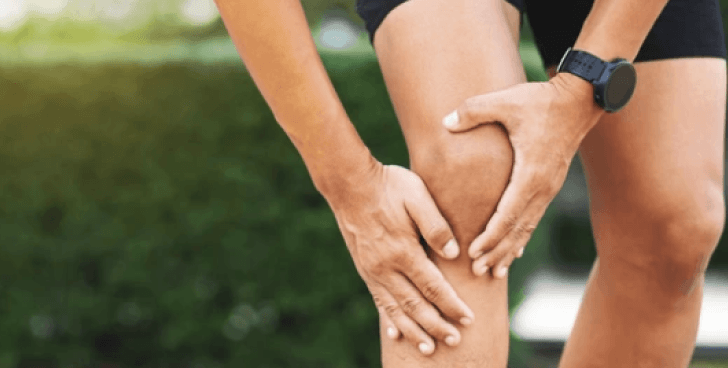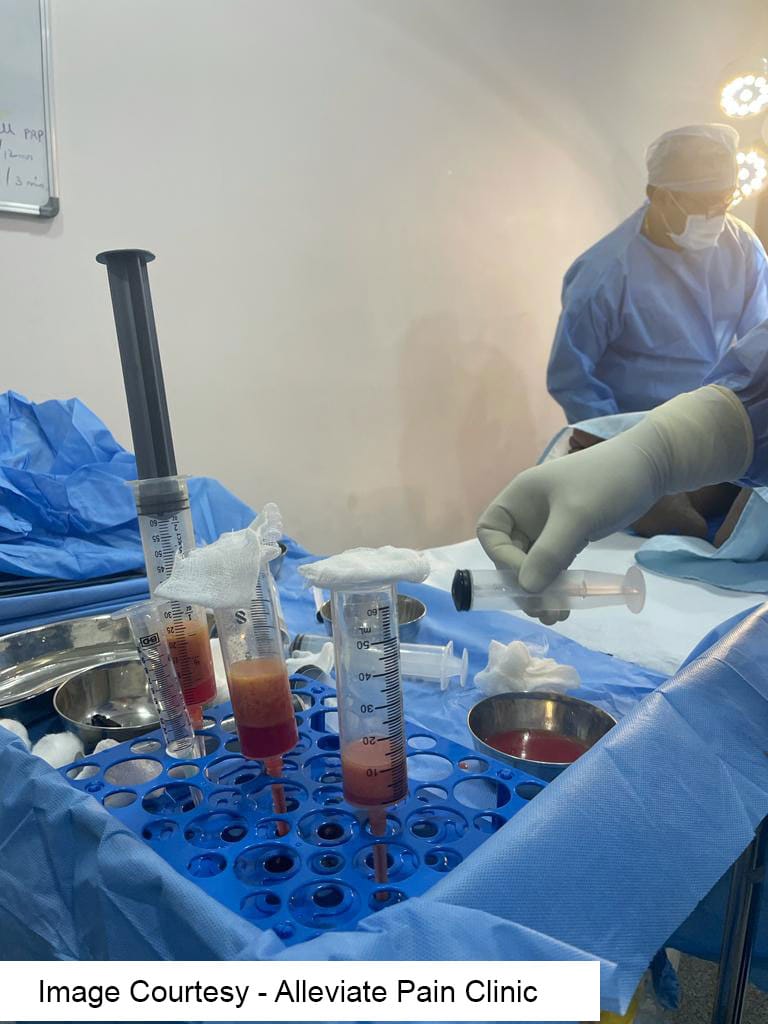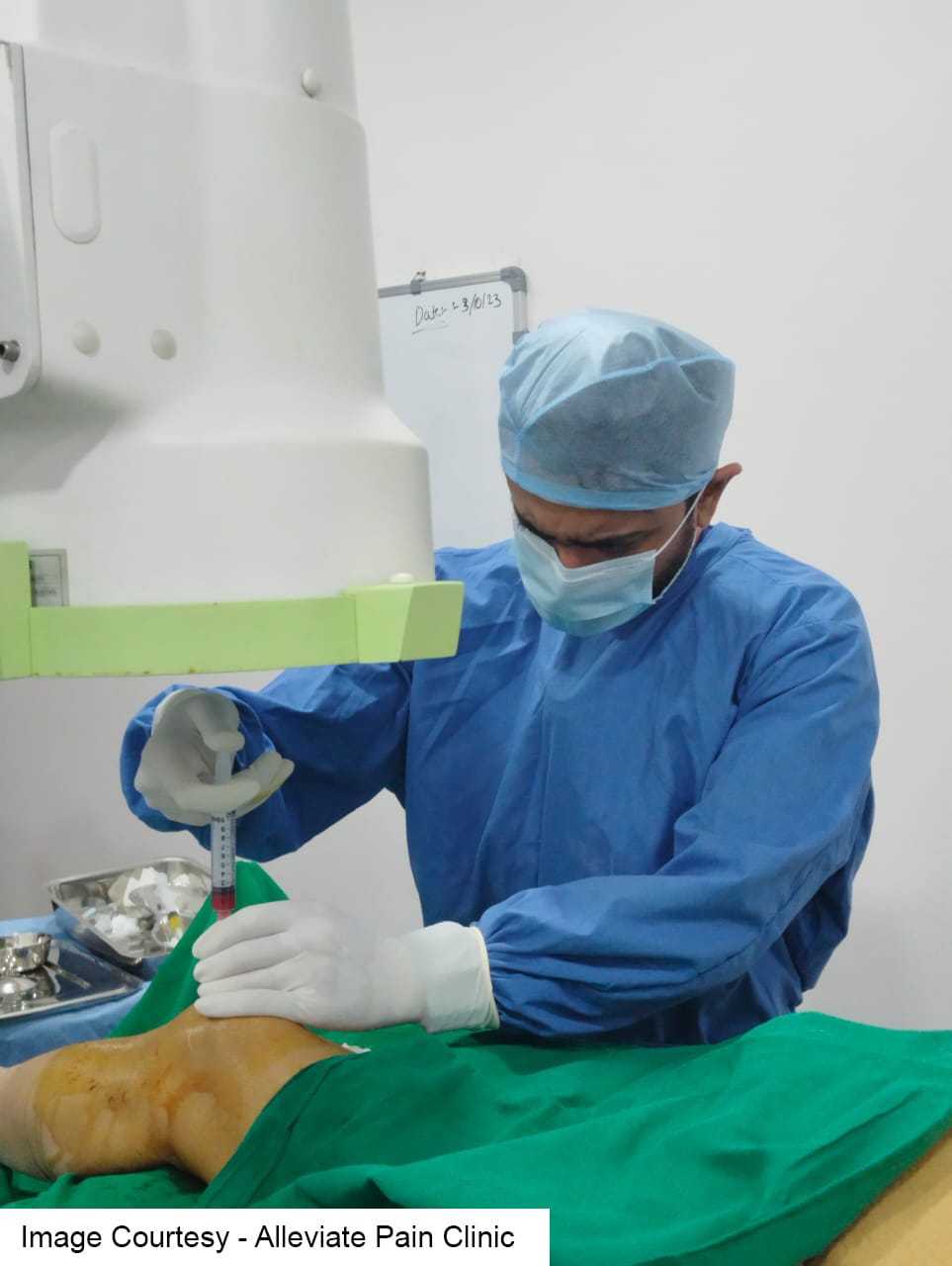
Introduction
Knee osteoarthritis (OA) is a common degenerative joint condition that affects millions of people worldwide, causing pain, stiffness, and reduced mobility. Traditional treatments for OA often focus on managing symptoms, but a revolutionary approach has emerged in recent years – stem cell therapy. This essay explores how stem cell therapy aids in knee osteoarthritis, delving into its mechanism of action, the extraction and preparation process, clinical improvement, and the multidisciplinary approach practiced at Alleviate Pain Clinic.
Mechanism of Action
- Chondrogenesis: Mesenchymal stem cells, derived from adipose tissue or bone marrow, play a pivotal role in the regenerative process for knee osteoarthritis. The mechanism of action involves the ability of MSCs to differentiate into chondrocytes, the specialized cells responsible for cartilage maintenance. This differentiation contributes to the regeneration of damaged cartilage, a hallmark of osteoarthritis. Notably, the regenerative capacity of MSCs extends beyond mere cell replacement. These cells produce bioactive factors, including growth factors and cytokines, creating a paracrine effect that modulates inflammation, promotes angiogenesis, and recruits endogenous repair cells to the site of injury (Caplan & Dennis, 2006; Murphy et al., 2013).
- Paracrine Signaling: MSCs release a myriad of bioactive molecules, including growth factors, cytokines, and extracellular vesicles, through paracrine signaling. This signaling cascade has anti-inflammatory effects, modulates immune responses, and stimulates the recruitment of endogenous repair cells to the site of injury (Teixeira et al., 2013).
Extracellular Vesicles (EVs): A Key Player
Recent studies have illuminated the role of extracellular vesicles (EVs) derived from MSCs in mediating the therapeutic effects observed in stem cell therapy for knee osteoarthritis. These nano-sized vesicles contain a cargo of bioactive molecules, including microRNAs and growth factors, that exert modulatory effects on cellular processes. EVs are believed to contribute to the anti-inflammatory and chondroprotective effects seen post-stem cell therapy, representing a crucial component of the paracrine signaling cascade (Lai et al., 2013).
Extraction and Preparation Process
Mesenchymal stem cell preparation from Patient’s Adipose tissue at Alleviate Pain Clinic, BengaluruThe success of stem cell therapy hinges on the effective extraction and preparation of MSCs. The two primary sources for harvesting MSCs are adipose tissue and bone marrow.
Adipose Tissue Harvesting
- A minimally invasive liposuction procedure is performed to collect adipose tissue from the patient.
- The harvested fat undergoes enzymatic digestion to isolate the stromal vascular fraction (SVF), containing MSCs.
- The SVF is then processed to obtain a concentrated solution of MSCs ready for injection into the knee joint.
Bone Marrow Harvesting
- Bone marrow is typically aspirated from the iliac crest or another suitable site.
- The aspirate contains a mixture of cells, including MSCs.
- The bone marrow-derived cells are processed to isolate and concentrate the MSCs.
Preparation for Injection
- The isolated MSCs are often further purified and concentrated to enhance their regenerative potential.
- Before injection, the prepared stem cell solution may be combined with other substances such as platelet-rich plasma (PRP) to optimize the therapeutic milieu.
The extraction and preparation process is designed to ensure the viability and potency of the harvested MSCs, maximizing their regenerative capabilities once introduced into the knee joint.
Clinical Results
Numerous clinical studies and trials have investigated the efficacy of stem cell therapy in treating knee osteoarthritis, providing valuable insights into the tangible benefits observed in patients.
Pain Reduction
A meta-analysis conducted by Gupta et al. (2020) examined multiple clinical trials and reported a consistent reduction in pain scores among patients receiving stem cell therapy. The mechanism underlying pain relief is multifaceted, involving both the regenerative effects of stem cells on damaged cartilage and their anti-inflammatory properties (Gupta et al., 2020).
- Reference: Gupta, P. K., Chullikana, A., Parakh, R., Desai, S., Das, A., & Gottipamula, S. (2020). A double-blind randomized placebo-controlled phase I/II study assessing the safety and efficacy of allogeneic bone marrow-derived mesenchymal stem cell in critical limb ischemia. Journal of Translational Medicine, 18(1), 159.
Functional Improvement
A randomized controlled trial by Emadedin et al. (2015) demonstrated significant improvements in knee function and performance in patients treated with adipose-derived mesenchymal stem cells. This included enhanced mobility, reduced stiffness, and increased range of motion, indicating a positive impact on overall joint function (Emadedin et al., 2015).
- Reference: Emadedin, M., Ghorbani Liastani, M., Fazeli, R., Mohseni, F., Moghadasali, R., Mardpour, S., … & Aghahossein Fanni, A. (2015). Long-term follow-up of intra-articular injection of autologous mesenchymal stem cells in patients with knee, ankle, or hip osteoarthritis. Archives of Iranian Medicine, 18(6), 336-344.
Cartilage Regeneration
Studies utilizing advanced imaging techniques, such as magnetic resonance imaging (MRI) and arthroscopy, have provided visual evidence of cartilage regeneration following stem cell therapy. Centeno et al. (2014) reported positive outcomes in a case series where MRI demonstrated increased cartilage volume and thickness in patients treated with bone marrow-derived stem cells (Centeno et al., 2014).
- Reference: Centeno, C. J., Al-Sayegh, H., & Bashir, J. (2014). A prospective multi-site registry study of a specific protocol of autologous bone marrow concentrate for the treatment of shoulder rotator cuff tears and osteoarthritis. Journal of Pain Research, 7, 289-298.
Disease Modification
Long-term follow-up studies have suggested a potential disease-modifying effect of stem cell therapy. In a study by Jo et al. (2014), patients treated with adipose-derived stem cells exhibited a slower progression of osteoarthritis compared to the control group, as evidenced by radiographic findings over a five-year period (Jo et al., 2014).
- Reference: Jo, C. H., Lee, Y. G., Shin, W. H., Kim, H., Chai, J. W., Jeong, E. C., … & Yoon, K. S. (2014). Intra-articular injection of mesenchymal stem cells for the treatment of osteoarthritis of the knee: a proof-of-concept clinical trial. Stem Cells, 32(5), 1254-1266.
Multidisciplinary Approach at Alleviate Pain Clinic
The hallmark of Alleviate Pain Clinic’s approach lies in the collaboration of diverse medical professionals, fostering a multidisciplinary setting that addresses the multifaceted nature of knee osteoarthritis. Orthopedic specialists, pain management physicians, regenerative medicine experts, and physical therapists work in tandem to tailor treatment plans for each patient. This collaborative effort ensures a holistic evaluation of the patient’s condition, considering factors beyond the joint itself, such as muscle imbalances, joint stability, and lifestyle elements.
- Comprehensive Evaluation: Patients undergo a thorough assessment to gauge the severity and specific characteristics of their knee osteoarthritis. This evaluation includes clinical examinations, imaging studies, and patient history reviews to create a personalized treatment plan.
- Individualized Treatment Protocols: Based on the evaluation, a customized treatment protocol is developed, integrating stem cell therapy with other modalities such as physical therapy, pain management interventions, and lifestyle modifications. This individualized approach acknowledges that knee osteoarthritis manifests differently in each patient.
- Optimizing Long-Term Outcomes: The multidisciplinary approach extends beyond immediate symptom relief, aiming to optimize long-term outcomes. Patients are guided through rehabilitative exercises, lifestyle adjustments, and pain management strategies, fostering a holistic approach to joint health.
Precise Image-Guided Procedures
Knee Intrarticular Mesenchymal Stem Cells(MSC) Injection done under fluoroscopy at Alleviate Pain Clinic Alleviate Pain Clinic employs state-of-the-art image-guided procedures to enhance the precision and efficacy of stem cell therapy for knee osteoarthritis. These procedures ensure that the injected stem cells reach the targeted area with accuracy, maximizing their regenerative impact.
- Fluoroscopy and Ultrasound Guidance: During stem cell injections, Alleviate Pain Clinic utilizes fluoroscopy and ultrasound guidance. Fluoroscopy provides real-time X-ray imaging, allowing physicians to visualize the joint and guide the needle precisely. Ultrasound offers high-resolution images, aiding in the accurate placement of the needle within the joint space.
- Targeted Delivery of Stem Cells: The use of image-guided procedures ensures that stem cells are delivered precisely to the affected area, optimizing their regenerative potential. This targeted approach is crucial for achieving optimal outcomes and minimizing the risk of complications.
- Minimally Invasive Techniques: Alleviate Pain Clinic prioritizes minimally invasive techniques to enhance patient comfort and reduce recovery times. The combination of image guidance and minimally invasive approaches reflects a commitment to providing effective and patient-friendly treatments.
Conclusion
Alleviate Pain Clinic’s distinctive approach to stem cell therapy for knee osteoarthritis, blending a multidisciplinary team and precision-guided procedures, sets a new standard in patient care. The collaborative efforts of orthopedic specialists, pain management experts, and regenerative medicine professionals create a comprehensive strategy that goes beyond immediate symptom relief, aiming for sustained joint health and improved overall well-being. As the clinic continues to innovate and refine its practices, the multidisciplinary and precision-focused approach stands as a beacon of hope for individuals grappling with the challenges of knee osteoarthritis.
References
- Lai, R. C., Yeo, R. W. Y., & Lim, S. K. (2013). Mesenchymal stem cell exosomes. Seminars in Cell & Developmental Biology, 24(11), 1253-1262.
- Gupta, P. K., Chullikana, A., Parakh, R., Desai, S., Das, A., & Gottipamula, S. (2020). A double-blind randomized placebo-controlled phase I/II study assessing the safety and efficacy of allogeneic bone marrow-derived mesenchymal stem cell in critical limb ischemia. Journal of Translational Medicine, 18(1), 159.
- Emadedin, M., Ghorbani Liastani, M., Fazeli, R., Mohseni, F., Moghadasali, R., Mardpour, S., … & Aghahossein Fanni, A. (2015). Long-term follow-up of intra-articular injection of autologous mesenchymal stem cells in patients with knee, ankle, or hip osteoarthritis. Archives of Iranian Medicine, 18(6), 336-344.
- Centeno, C. J., Al-Sayegh, H., & Bashir, J. (2014). A prospective multi-site registry study of a specific protocol of autologous bone marrow concentrate for the treatment of shoulder rotator cuff tears and osteoarthritis. Journal of Pain Research, 7, 289-298.
- Jo, C. H., Lee, Y. G., Shin, W. H., Kim, H., Chai, J. W., Jeong, E. C., … & Yoon, K. S. (2014). Intra-articular injection of mesenchymal stem cells for the treatment of osteoarthritis of the knee: a proof-of-concept clinical trial. Stem Cells, 32(5), 1254-1266.





